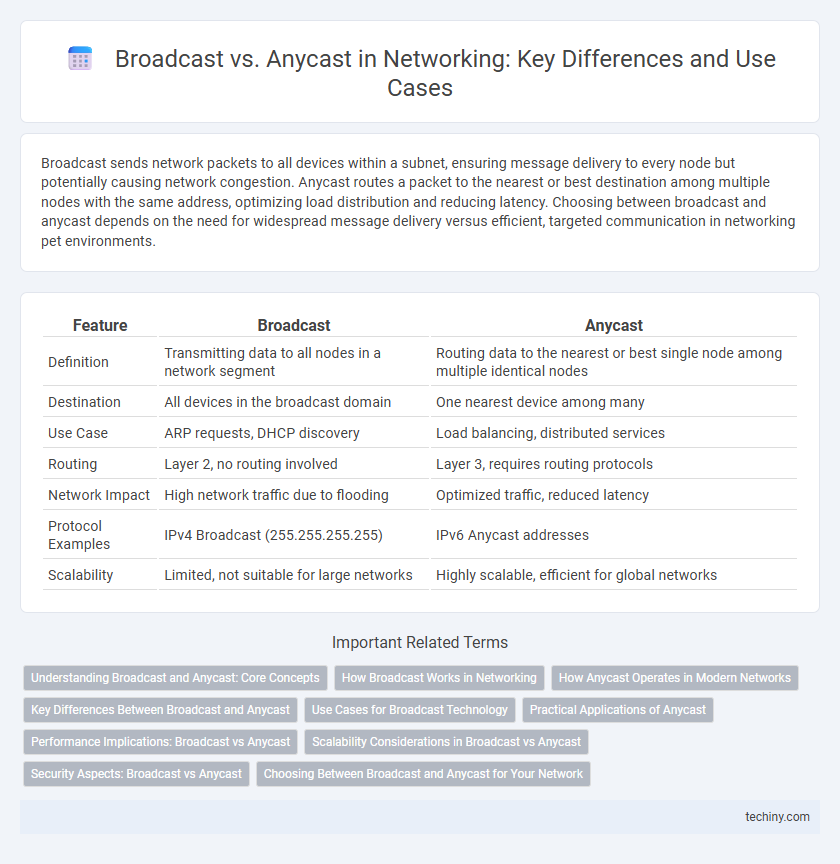Broadcast sends network packets to all devices within a subnet, ensuring message delivery to every node but potentially causing network congestion. Anycast routes a packet to the nearest or best destination among multiple nodes with the same address, optimizing load distribution and reducing latency. Choosing between broadcast and anycast depends on the need for widespread message delivery versus efficient, targeted communication in networking pet environments.
Table of Comparison
| Feature | Broadcast | Anycast |
|---|---|---|
| Definition | Transmitting data to all nodes in a network segment | Routing data to the nearest or best single node among multiple identical nodes |
| Destination | All devices in the broadcast domain | One nearest device among many |
| Use Case | ARP requests, DHCP discovery | Load balancing, distributed services |
| Routing | Layer 2, no routing involved | Layer 3, requires routing protocols |
| Network Impact | High network traffic due to flooding | Optimized traffic, reduced latency |
| Protocol Examples | IPv4 Broadcast (255.255.255.255) | IPv6 Anycast addresses |
| Scalability | Limited, not suitable for large networks | Highly scalable, efficient for global networks |
Understanding Broadcast and Anycast: Core Concepts
Broadcast involves sending data packets from one source to all devices within a network segment, maximizing reach but causing potential network congestion. Anycast directs data to the nearest or best destination among multiple potential receivers sharing the same IP address, optimizing routing efficiency and reducing latency. Understanding these core concepts is crucial for designing scalable and efficient network architectures.
How Broadcast Works in Networking
Broadcast in networking transmits data packets from a single source to all devices within a specific network segment using a broadcast address, typically the highest address in the subnet. It operates at the Data Link layer (Layer 2) by sending frames to the broadcast MAC address FF:FF:FF:FF:FF:FF, ensuring every device on the local network receives the transmission simultaneously. This method is essential for services like ARP (Address Resolution Protocol) and DHCP (Dynamic Host Configuration Protocol), which require widespread network reachability without targeting specific destinations.
How Anycast Operates in Modern Networks
Anycast operates in modern networks by assigning the same IP address to multiple servers located in different geographical locations, enabling data packets to be routed to the nearest or best-performing server. This routing method enhances load balancing, reduces latency, and improves network resilience by directing user requests dynamically based on real-time network conditions. Unlike broadcast, which sends data to all nodes within a network segment, anycast ensures efficient resource utilization by delivering information only to a single, optimal recipient among many.
Key Differences Between Broadcast and Anycast
Broadcast sends data packets to all devices within a network segment, ensuring every node receives the transmission, which can lead to network congestion. Anycast directs data to the nearest or best-performing node among multiple identical servers, optimizing resource use and reducing latency. Broadcast is typically limited to local area networks (LANs), while anycast operates across wide area networks (WANs) and the internet for efficient content delivery and load balancing.
Use Cases for Broadcast Technology
Broadcast technology is ideal for network scenarios requiring data delivery to all devices within a local subnet, such as ARP requests or DHCP server discovery. It efficiently supports services like network announcements and device discovery protocols that rely on simultaneous message dissemination. Broadcast minimizes configuration complexity in small to medium-sized LANs where group communication is essential.
Practical Applications of Anycast
Anycast is predominantly used in content delivery networks (CDNs) and DNS services to direct user requests to the nearest or best-performing server, enhancing load balancing and reducing latency. Its implementation in distributed denial-of-service (DDoS) mitigation allows traffic to be dispersed across multiple nodes, improving network resilience and availability. Unlike broadcast, which sends data to all nodes in a network segment, anycast efficiently targets multiple locations with a single IP address, optimizing resource utilization in large-scale network deployments.
Performance Implications: Broadcast vs Anycast
Broadcast traffic sends packets to all nodes within a network segment, resulting in increased bandwidth consumption and potential network congestion that degrades overall performance. Anycast routes packets to the nearest or best-performing node based on routing metrics, optimizing latency and resource utilization by minimizing unnecessary traffic. Choosing anycast over broadcast improves network efficiency, reduces packet collisions, and enhances scalability in large distributed environments.
Scalability Considerations in Broadcast vs Anycast
Broadcast techniques face significant scalability challenges as network size increases, leading to excessive traffic and resource consumption on all nodes. Anycast improves scalability by directing data to the nearest or best destination among multiple potential receivers, reducing overall network load and enhancing efficiency. Large-scale deployments benefit from anycast's ability to minimize latency and optimize bandwidth usage compared to broadcast flooding methods.
Security Aspects: Broadcast vs Anycast
Broadcast communication exposes a network to higher security risks by sending data packets to all nodes, increasing the attack surface for potential interception or denial-of-service attacks. Anycast limits exposure by routing data to the nearest or most optimal node, minimizing unnecessary data dissemination and reducing vulnerability to interception. Security protocols combined with anycast improve network resilience by isolating threats and enhancing traffic control.
Choosing Between Broadcast and Anycast for Your Network
Choosing between broadcast and anycast depends on network size, traffic patterns, and application requirements. Broadcast sends packets to all devices within a network segment, suitable for small, local environments but inefficient at scale and prone to congestion. Anycast routes data to the nearest or best destination node, optimizing resource use and improving latency for distributed services like DNS and content delivery networks.
Broadcast vs Anycast Infographic

 techiny.com
techiny.com